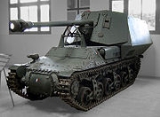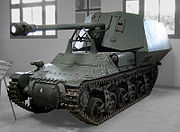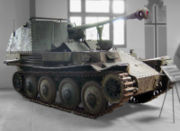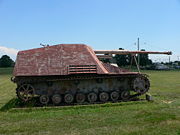
Panzerjäger
Encyclopedia



Panzerjäger was a branch of service of the Wehrmacht
Wehrmacht
The Wehrmacht – from , to defend and , the might/power) were the unified armed forces of Nazi Germany from 1935 to 1945. It consisted of the Heer , the Kriegsmarine and the Luftwaffe .-Origin and use of the term:...
during the Second World War
World War II
World War II, or the Second World War , was a global conflict lasting from 1939 to 1945, involving most of the world's nations—including all of the great powers—eventually forming two opposing military alliances: the Allies and the Axis...
which were the anti-tank
Anti-tank warfare
Anti-tank warfare was created by the need to seek technology and tactics to destroy tanks and their supporting infantry during the First World War...
arm-of-service who operated anti-tank artillery, and made exclusive use of the tank destroyers which were also named Panzerjäger. They wore ordinary field-gray uniforms rather than the black of the Panzer troops; those Panzerjäger troops who crewed the tank-destroyers however wore the Panzer jacket in field gray.
Development
From 1940 the Panzerjäger troops were equipped with vehicles produced by mounting an existing anti-tank gun complete with the gun shield on a tracked chassis to allow higher mobility.Development of the Panzerjäger designs begun before the war with the Sturmgeschütz
Sturmgeschütz
Sturmgeschütz is a German word for "assault gun", usually abbreviated StuG. The vehicle was a leading weapon of the Sturmartillerie, a branch of the German artillery tasked with close fire support of infantry in infantry, panzer, and panzergrenadier units...
-designated armored vehicles, the initial German turretless tanks to use completely closed-in armored casemate
Casemate
A casemate, sometimes rendered casement, is a fortified gun emplacement or armored structure from which guns are fired. originally a vaulted chamber in a fortress.-Origin of the term:...
s, and continued until 1944, resulting in such casemate-design vehicles as the Jagdpanzer
Jagdpanzer
Jagdpanzer , German for "hunting tank", is a name given to German self-propelled anti-tank guns.It typically refers to anti-tank variants of existing tank chassis with a well-armoured casemate fixed superstructure, mounting an anti-tank gun with limited traverse in the front, and usually classed by...
("Hunting tanks"), purpose-built heavy-gun tank destroyers. These usually used upward extensions of both the glacis plate and hull sides to comprise three sides of their closed-in casemates. Panzerjäger continued to serve as a separate branch of the Heer until the end of the war, often replacing tanks due to production shortages.
Initially chassis of captured light tanks were used after turrets were removed, providing a cost-effective solution to German shortage of mobile anti-tank weapons in infantry divisions. Despite the shortcomings of light armour and high silhouette they were successfully used in their intended role.
Organisation
From 1943 the Type 44 infantry divisions included the following divisional Panzerjäger-Abteilung:- Staff company (Stabskompanie)
- 1. Panzerjäger-Kompanie equipped with 9 - 12 towed AT guns
- 2. StuG-Batterie equipped with ten StuG III, IV or Hetzer vehicles
- 3. Light anti-aircraft company (leichte FlaK-Kompanie) equipped with 12 towed 20 mm FlaK autocannons
Combat use
Panzerjäger units were either assigned as 14th companies companies in infantry regiments, or as a whole AbteilungAbteilung
Abteilung is a German language word often used when referring to German or Swiss military formations...
(battalions) within Panzer and Panzergrenadier divisions, in both SS and Heer. Independent battalions and regiments were used by Corps
Corps
A corps is either a large formation, or an administrative grouping of troops within an armed force with a common function such as Artillery or Signals representing an arm of service...
to protect most likely avenues of tank attacks, while divisions would often position their Panzerjäger on the flanks, or use them to support infantry advances against enemy using tanks. When used with tanks, despite intense inter-branch rivalry
Interservice rivalry
Interservice rivalry is a military term referring to rivalries that can arise between different branches of a country's armed forces, such as between a nation's land forces , naval and air forces. It also applies to the rivalries between a country's intelligence services, Central Intelligence...
, Panzerjäger would work in teams, with the tank crews enticing enemy tanks to fire, disclosing their position, and Panzerjäger engaging the enemy from a defilade. Panzerjäger were often called upon to provide direct high explosive supporting fire to infantry by destroying machinegun and artillery positions, particularly in urban fighting.
Vehicle designs
Designs of the Panzerjäger vehicles varied based on the chassis used, which could be of three types:- Early war open-toped superstructure on a light tank chassis
- Mid-war fully enclosed crew compartment on a medium or heavy tank chassis
- Late war unarmoured or shielded mounting on a half-track chassis
Notable tank destroyers in the Panzerjäger classification were:
- Panzerjäger IPanzerjäger IThe Panzerjäger I was the first of the German tank destroyers to see service in the Second World War. It mounted a Czech Skoda cm PaK anti-tank gun on a converted Panzer I Ausf. B chassis...
- 47 mm PaK on Panzer IPanzer IThe Panzer I was a light tank produced in Germany in the 1930s. The name is short for the German ' , abbreviated . The tank's official German ordnance inventory designation was SdKfz 101 .Design of the Panzer I began in 1932 and mass production in 1934...
chassis - Marder IMarder IThe Marder I "Marten" was a German World War II tank destroyer, armed with the 75 mm anti-tank gun. Most Marder I's were built on the base of the Tracteur Blindé 37L , a French artillery tractor/armoured personnel carrier of which the Germans had acquired more than three hundred after the Fall of...
- 75 mm PaK on captured French chassis, the Lorraine 37LLorraine 37LThe Lorraine 37L or Tracteur de ravitaillement pour chars 1937 L, was a light tracked armoured vehicle developed during the Interbellum by the Lorraine company to a French Army requirement for a munition and fuel supply carrier to be used by tank units. A prototype was built in 1937 and production... - Marder IIMarder IIThe Marder II was a German tank destroyer of World War II based on the Panzer II chassis.-History:During the very first days of Operation Barbarossa, the invasion of the Soviet Union, the Germans were shocked to encounter Soviet T-34 medium tanks and KV heavy tanks...
- 75 mm PaK or reused Soviet 76.2 mm gun on Panzer IIPanzer IIThe Panzer II was the common name for a family of German tanks used in World War II. The official German designation was Panzerkampfwagen II...
chassis - Marder IIIMarder IIIThe Marder III is the name for a series of World War II German tank destroyers built on the chassis of the Panzer 38. The German word Marder means "marten" in English...
- 75 mm PaK or reused Soviet 76.2 mm gun on Czech-built Panzer 38(t)Panzer 38(t)The Panzerkampfwagen 38 was originally a Czech tank of pre-World War II design. After Czechoslovakia was taken over by Germany, it was adopted by the German Army, seeing service in the invasions of Poland and Russia. Production ended in 1942, when its armament was deemed inadequate. In all, over...
chassis - Hornisse/NashornNashornNashorn , initially known as Hornisse , was a German tank destroyer of World War II. It was developed as an interim solution in 1942 and was armed with the outstanding Pak 43 anti-tank gun...
- 88 mm PaK on composite Panzer IIIPanzer IIIPanzer III was the common name of a medium tank that was developed in the 1930s by Germany and was used extensively in World War II. The official German designation was Panzerkampfwagen III translating as "armoured battle vehicle". It was intended to fight other armoured fighting vehicles and...
/Panzer IVPanzer IVThe Panzerkampfwagen IV , commonly known as the Panzer IV, was a medium tank developed in Nazi Germany in the late 1930s and used extensively during the Second World War. Its ordnance inventory designation was Sd.Kfz...
chassis - Sturmgeschütz IVSturmgeschütz IVThe Sturmgeschütz IV , was a German assault gun of the Second World War.-Development:The Sturmgeschütz IV resulted from Krupp's effort to supply an assault gun...
- Jagdpanzer 38(t)
- JagdpantherJagdpantherThe Jagdpanther was a tank destroyer built by Nazi Germany during World War II based on the chassis of the Panther tank. It entered service late in the war and saw service on the Eastern and Western fronts...
- Jagdpanzer IVJagdpanzer IVThe Jagdpanzer IV, Sd.Kfz. 162, was a tank destroyer based on the Panzer IV chassis built in three main variants. As one of the casemate-style turretless Jagdpanzer designs, it was developed against the wishes of Heinz Guderian, the inspector general of the Panzertruppen, as a replacement for the...
- JagdtigerJagdtigerJagdtiger is the common name of a German tank destroyer of World War II. The official German designation was Panzerjäger Tiger Ausf. B. The ordnance inventory designation was Sd. Kfz. 186. It saw service in small numbers from late 1944 to the end of the war on both the Western and Eastern Front...
See also
- DeaconDeacon (artillery)The AEC Mk I Gun Carrier, known as Deacon, was a British armoured fighting vehicle of the Second World War. It was an attempt to make the QF 6 pounder anti-tank gun into a self-propelled artillery piece...
- a British mobile anti-tank gun. - M56 ScorpionM56 ScorpionThe M56 Scorpion was an unarmored American self-propelled anti-tank gun, which featured a 90mm M54 gun with a simple blast shield, and unprotected crew compartment...
- an US self-propelled gun

